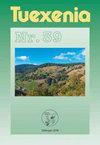碱草原的降雨波动和植被模式——使用自组织地图可视化植被动态
IF 1.1
4区 生物学
Q3 PLANT SCIENCES
引用次数: 21
摘要
了解草原植被动态的驱动因素是为保护目的选择适当管理的基础。在这项研究中,我们提供了一个详细的分析在碱草原植被动态,自然2000网络的优先生境。2009 - 2011年,对匈牙利东部Hortobagy国家公园4种碱草地类型5个林分的植被动态进行了研究。利用自组织地图神经网络(SOM)分析了降水波动对植被总体组成和各物种覆盖度的影响。我们发现SOM是一个很有前途的揭示植物群落动态的工具。当我们分别分析物种覆盖和整体植被组成时,我们能够确定导致特定植被变化的物种。降水的波动(一个干季,接着是一个湿季和一个平均季)引起了植物物种组成的快速变化,这可能是因为盐碱化导致盐生植物的覆盖面积增加。我们观察到,在所有研究的草地类型中,内涝胁迫的影响相似。在不同降水条件下,普契利亚草原的物种组成最稳定。这一点很重要,因为这种草地类型含有许多受威胁的盐生植物物种。自组织地图揭示了小尺度的植被变化,并提供了短期植被动态的详细可视化,因此我们认为这种方法的应用也有望揭示物种丰富的栖息地类型或景观中的群落动态。本文章由计算机程序翻译,如有差异,请以英文原文为准。
Rainfall fluctuations and vegetation patterns in alkali grasslands - using self-organizing maps to visualise vegetation dynamics
Knowledge about the drivers of vegetation dynamics in grasslands is fundamental to select appro-priate management for conservation purposes. In this study, we provide a detailed analysis of vegeta-tion dynamics in alkali grasslands, a priority habitat of the Natura 2000 network. We studied vegetation dynamics in five stands of four alkali grassland types in the Hortobagy National Park (eastern Hunga-ry), between 2009 and 2011. We analysed the effect of fluctuations in precipitation on both the overall vegetation composition and on the cover of each species using Self Organizing Map neural networks (SOM). We found that SOM is a promising tool to reveal plant community dynamics. As we analysed species cover and overall vegetation composition separately, we were able to identify the species re-sponsible for particular vegetation changes. Fluctuations in precipitation (a dry season, followed by a wet and an average season) caused quick shifts in plant species composition because of an increasing cover of halophyte forbs, probably because of salinisation. We observed a similar effect of stress from waterlogging in all studied grassland types. The species composition of Puccinellia grasslands was the most stable over the three years with varying precipitation. This was important as this grassland type contained many threatened halophyte species. Self-organising maps revealed small-scale vegetation changes and provided a detailed visualisation of short-term vegetation dynamics, thus we suggest that the application of this method is also promising to reveal community dynamics in more species-rich habitat types or landscapes.
求助全文
通过发布文献求助,成功后即可免费获取论文全文。
去求助
来源期刊

Tuexenia
PLANT SCIENCES-
CiteScore
2.80
自引率
25.00%
发文量
0
期刊介绍:
Tuexenia publiziert Original- und Übersichtsarbeiten sowie Berichte zu Themen der Geobotanik / Vegetationsökologie und zu Nachbarwissenschaften wie Populationsökologie, Biodiversitätsforschung, Biozönologie, Renaturierungsökologie und ihren Anwendungen, vor allem im Naturschutz. Der geografische Schwerpunkt liegt in Zentraleuropa und angrenzenden Regionen.Tuexenia erscheint jährlich in einem Band, der etwa zur Jahresmitte fertig gestellt wird. Autoren erhalten von jeder Arbeit eine PDF-Datei und gemeinsam 20 Sonderdrucke kostenlos.
Die Qualität der wissenschaftlichen Manuskripte wird durch die Redaktion und einen Wissenschaftlichen Beirat (Peer Review) gesichert (s. auch die Manuskript-Richtlinien vor dieser Seite). Es werden keine Druckkosten erhoben. Tuexenia legt Wert auf allgemeine Online-Verfügbarkeit der Beiträge.
 求助内容:
求助内容: 应助结果提醒方式:
应助结果提醒方式:


